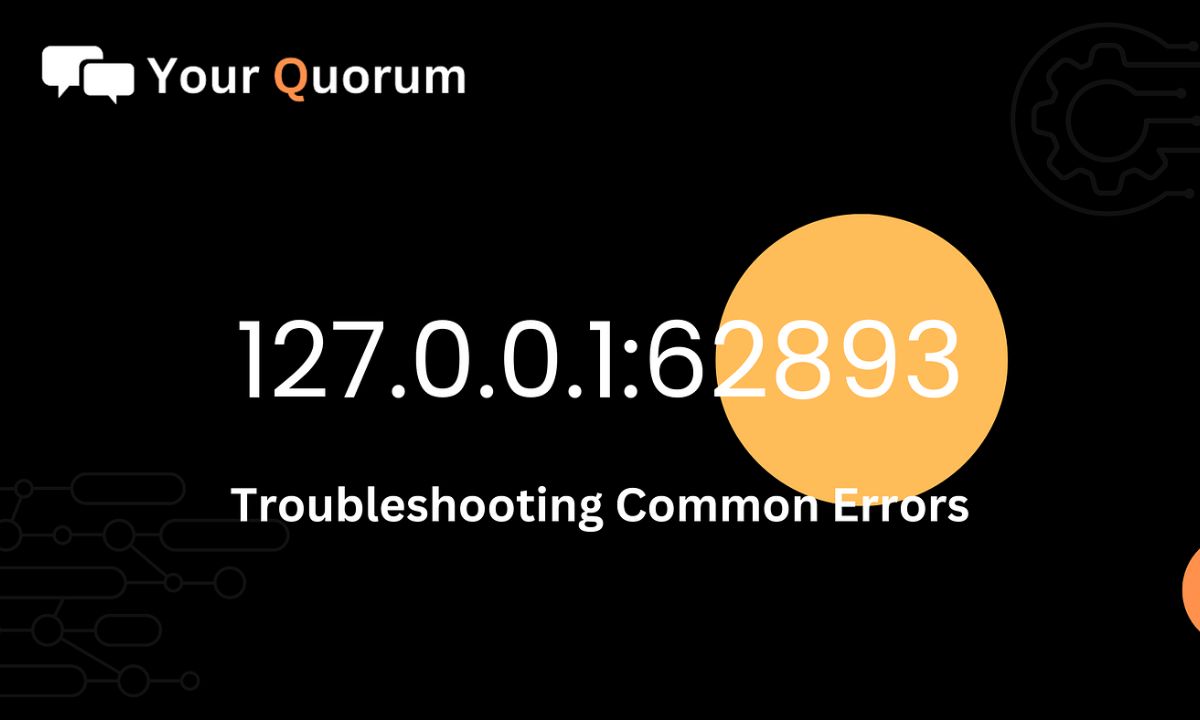Understanding the IP address 127.0.0.1 and its associated port 62893 is crucial for anyone involved in web development or network management.
This address is commonly referred to as localhost or the loopback address. It allows developers to test applications and services locally without external network dependencies.
This article will cover the significance of this address, its applications, and how to troubleshoot common issues.
What is 127.0.0.1?
127.0.0.1 is a special IP address that refers to the local machine. It is used for testing and development purposes. This address enables a computer to communicate with itself. This is vital for developers who need to run applications without relying on an external network.
The loopback address is built into the Internet Protocol (IP). When you send data to 127.0.0.1, it does not leave your machine. This allows for quick testing of applications. You can run servers, databases, and other services locally using this address.
Uses of 127.0.0.1
Many applications leverage 127.0.0.1 for local testing. For instance, web developers often run their servers on this address. By doing so, they can check their work before going live. This prevents potential issues that might arise when deploying to an actual server.
When you access 127.0.0.1 in a web browser, it directs you to the local server. This gives you a chance to see how your application works in a real environment. It is an ideal way to debug and make improvements.
The Significance of Loopback and Localhost
The loopback address 127.0.0.1 allows a computer to communicate with itself, enabling secure and efficient local testing and development. It provides a vital environment for developers to ensure applications function correctly before deployment.
Importance of Loopback
The concept of the loopback interface is significant in networking. It allows the device to send and receive data to itself. This is crucial for testing purposes. By using the loopback address, developers can simulate network operations. They can check if their applications are functioning correctly.
Localhost is synonymous with 127.0.0.1. This term is used in various contexts, including web development and software testing. It provides a safe environment for developers to run their applications. They can ensure everything works as intended without the risks associated with external networks.
Benefits of Using Localhost
Using localhost offers several benefits. It enhances security since no data is transmitted over the internet. This is especially important for applications handling sensitive information. Developers can test features without worrying about data breaches or security vulnerabilities.
Localhost also speeds up the development process. Accessing 127.0.0.1 is faster than connecting to an external server. This means quicker load times and more efficient debugging. Developers can make changes and see the results almost instantly.
The Role of Port Numbers

Port numbers are essential for directing network traffic to specific applications on a device. They allow multiple services to run simultaneously without interference, ensuring efficient communication between different programs. Each port serves a unique purpose, enabling organized management of network resources.
Understanding Port Numbers
Port numbers are essential for managing network traffic. They help direct data to the appropriate application on a device. Each service running on a computer listens on a specific port. When you use 127.0.0.1:62893, the port number 62893 identifies the service you want to access.
Every device can handle multiple services simultaneously. By using different port numbers, these services can operate without interference. This organization is crucial for developers who run several applications on their localhost.
Port Number Ranges
Ports range from 0 to 65535. The first 1024 ports are known as well-known ports. They are reserved for standard services like HTTP and FTP. Ports 1024 to 49151 are registered ports. They are used for lesser-known services but still have some control. Ports from 49152 to 65535 are dynamic or private. These are often used temporarily for client-server communications.
Understanding these ranges helps developers choose the right port for their applications. For example, if a developer wants to run a web server, they might choose port 80 for HTTP. However, for local development, they could use higher, less common ports like 62893.
10 Very Informative Points on 127.0.0.1:62893
127.0.0.1 enables internal communication within a computer, allowing for testing without external networks. Port 62893 identifies specific services, supporting multiple applications simultaneously. This setup enhances security, serves as a diagnostic tool, and is essential for web development and database access. It also allows flexible configuration and supports command-line tools for detailed testing. Overall, it is a vital resource for developers.
Key Features of 127.0.0.1:62893
- Loopback Functionality: 127.0.0.1 allows a computer to communicate internally.
- Testing Environment: Developers can test applications without external network connections.
- Port Number Usage: The port number 62893 identifies specific services running on the machine.
- Security Benefits: Traffic on 127.0.0.1 does not leave the computer, ensuring data protection.
- Diagnostic Capabilities: It helps diagnose network setups and issues.
- Web Development Tool: Local servers can be tested using this address.
- Database Access: Local databases can be accessed securely and efficiently.
- Firewall Management: Using 127.0.0.1 allows for controlled access to services.
- Configuration Flexibility: Services can be configured to listen on any available port.
- Tool Support: Command-line tools can interact with localhost for testing.
These points illustrate the versatility and importance of 127.0.0.1:62893 in development environments.
Practical Applications of 127.0.0.1:62893

127.0.0.1:62893 is widely used in web development, allowing developers to run and test local servers before deployment. It provides a secure environment for accessing local databases, ensuring data security and performance.
Web Development
In web development, 127.0.0.1 is invaluable. Developers set up local servers to test their websites. Accessing http://127.0.0.1:62893 lets them see how their application behaves. They can interact with their code in real-time. This helps identify bugs before going live.
Local testing also allows developers to experiment. They can try new features without affecting the main site. This is crucial for ensuring a smooth user experience once the site is launched.
Local Databases
Databases are often configured to listen on localhost. For example, MySQL or MongoDB can use 127.0.0.1:62893 for local queries. This setup enhances security. It ensures that sensitive data does not leave the local machine during testing.
By utilizing localhost for databases, developers can also improve performance. Data retrieval and storage processes run faster without network latency. This is especially useful in development stages where efficiency is key.
Network Diagnostics
Network engineers frequently use the loopback address for diagnostics. By pinging 127.0.0.1, they can confirm that the TCP/IP stack is operational. This step is essential when troubleshooting network issues. It helps ensure that the internal network components are functioning correctly.
Using localhost for diagnostics also eliminates concerns about external factors. Engineers can focus solely on the device’s internal configuration. This simplifies the troubleshooting process and leads to quicker resolutions.
Read This Blog Also : iZoneMedia360.com: Revolutionizing Digital Presence with Comprehensive Solutions
How to Use 127.0.0.1:62893
Enter 127.0.0.1:62893 in a web browser to access local services for real-time testing. You can also use command-line tools like curl or telnet to send requests, enabling efficient debugging and interaction with localhost applications.
Accessing Localhost
To access services running on 127.0.0.1:62893, simply input the address in a web browser. If a web server is active on that port, the site will load. This allows for real-time testing of applications and websites.
This approach is straightforward and effective. Developers can immediately see how their changes affect the application. It provides instant feedback, which is crucial during the development process.
How to Get Your Computer’s IP Address
Finding your computer’s IP address is easy. On Windows, open the Start menu and type CMD to access the Command Prompt. Then type ipconfig and press Enter. This will display your local IP address.
For Linux users, press Ctrl + Alt + T to open the terminal. Type ip addr show and hit Enter. This command will reveal your computer’s IP address, allowing you to verify your network configuration.
Using Command Line Tools
Command-line tools like curl, telnet, and netcat can be used to interact with 127.0.0.1:62893. These tools allow you to send requests, test responses, and debug local services effectively. They provide a powerful way to analyze and troubleshoot applications running on your machine.
Command Line Interactions
Command-line tools are invaluable for testing localhost services. Tools like curl, telnet, and netcat can send requests to 127.0.0.1:62893. This allows developers to check server responses and troubleshoot issues.
Using these tools provides a deeper understanding of how applications interact with the network. Developers can simulate various conditions and observe how their applications perform under different scenarios.
Security Considerations

While 127.0.0.1 is inherently secure as traffic remains local, it’s important to manage which services are exposed. Regularly check firewall settings to prevent unauthorized access to specific ports.
Managing Localhost Security
While localhost is secure, it is still essential to manage which services are exposed. Malware can exploit services listening on unexpected ports. Regular security checks and firewall rules can help mitigate these risks.
Creating a secure environment for development is crucial. Developers should ensure that only necessary services are accessible. This helps protect sensitive data and maintain the integrity of the development process.
Frequently Asked Questions on 127.0.0.1:62893
What is 127.0.0.1 used for?
127.0.0.1 is used as a loopback address, allowing a computer to communicate with itself for testing and development purposes.
Why is a specific port number like 62893 used?
Port 62893 specifies a service running on the local machine, allowing multiple services to operate without conflict.
Can traffic to 127.0.0.1 be accessed from other machines?
No, traffic to 127.0.0.1 is internal and cannot be accessed from other devices on the network.
How can I see what service is running on 127.0.0.1:62893?
You can use tools like netstat or lsof to identify which application is using port 62893.
Is it possible to change the port number used with 127.0.0.1 for a specific service?
Yes, you can configure services to listen on different ports based on your requirements.
Conclusion
Mastering 127.0.0.1:62893 is essential for developers and network engineers. This loopback address provides a safe and efficient way to test applications locally. By understanding its significance and applications, developers can enhance their workflows.
Utilizing localhost effectively ensures that systems operate smoothly before going live. This knowledge is crucial for anyone involved in web development or network management.

Sahar is a talented content writer and digital marketer with expertise in SEO, social media management, and online marketing. She excels at creating impactful, data-driven content to help businesses connect with their target audience and achieve measurable outcomes.





